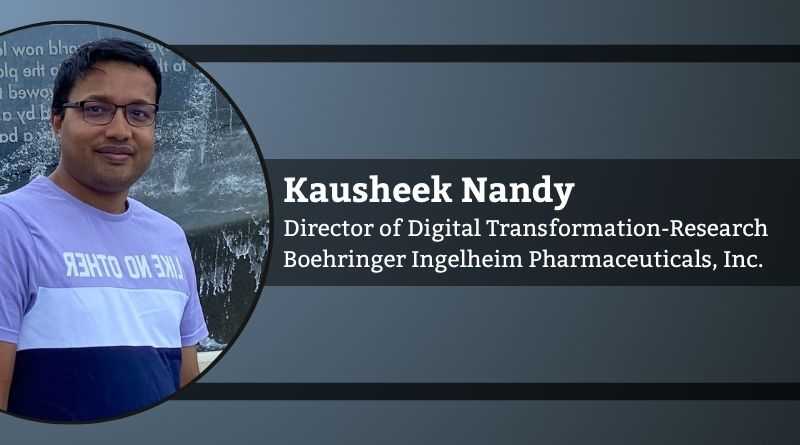Navigating the Digital Transformation Journey: Key Focus areas
By Kausheek Nandy, Director of Digital Transformation-Research, Boehringer Ingelheim Pharmaceuticals, Inc.
Digital transformation is a vast and multifaceted journey that encompasses various aspects of technology, culture, and organizational change. As the Director of Digital Transformation in Research for Boehringer Ingelheim, the privilege of navigating this complex landscape and driving meaningful change within the large molecule research organization has been a significant learning and fulfilling experience. Initially, my expectation was to leverage experience leading AI and data science teams easily. However, it quickly became apparent that AI and ML are just one part of the broader digital transformation puzzle.
One of the initial hurdles encountered was the state of the data. While data was available, it was far from being FAIR (Findable, Accessible, Interoperable, and Reusable). To address this, there was a need to bring data discipline to the organization and ensure that every scientist reports data consistently. Governance was lacking, and the first step was to establish a governance team with representatives from each functional area. The team was chaired by a key principal scientist who is a scientific leader and co-chaired by a senior IT business partner. Initially, it was challenging to achieve attendance, but over time, we not only increased attendance but also fostered engagement and positive contributions. Other departments that use our data joined the governance team, further strengthening the efforts. This success can be attributed to the fact that the people running the governance team have a stake in the process and are not independent full-time jobs.
As success was seen in this concept, another critical aspect of digital transformation, especially for the life sciences industry, emerged—R&D labs. These labs are where life-saving drugs for patients are discovered, where the real magic happens. The question was, how can the labs be made more efficient and automated so scientists can devote more time to science and drug discovery? To tackle this, a Data and Automation Team Lead and an Automation Specialist were hired. An Automation Task Force was established with representatives from different functions, and a vision for automating the labs based on a maturity model of different levels (L0-L4), ranging from manual to scripted to systematic to AI-enabled to fully autonomous labs, was developed.
Digital transformation is a dynamic and ongoing process that requires a holistic approach. It involves not only leveraging advanced technologies like AI and ML but also fostering a culture of discipline, governance, and continuous improvement.
Meanwhile, another reality of today’s digital age is that there are many brilliant scientists who know how to code. There was a need to manage not only out-of-the-box software but also in-silico protocols developed in-house. This led to the formation of an IT Product Team comprising IT SMEs, UX/frontend, and backend developers. An internal website/portal was built, which served as a scientist-driven, practical mechanism to formalize and standardize in-silico protocols. The scientist-centric nature of the portal encourages forward-thinking and is well-positioned to enable next-generation digital tools, including AI and ML solutions.
At this point, a small AI/ML team was set up as an integral part of the Digital Transformation group. Various AI/ML use cases from the department were collected and prioritized with a focus on rapid incremental value creation. This approach allows tangible results to be delivered quickly and builds momentum for further digital transformation initiatives. It also highlights the importance of domain knowledge or subject matter expertise. A common mistake many large organizations make is having a centralized team in data science, engineering, etc., whereas the real impact comes from domain experience. Hence, these teams need to be deeply embedded in the core business. Today, ChatGPT can write thousands of lines of code while one enjoys a game on TV; what ChatGPT can’t provide is real-world experience and domain knowledge. Rapid evolution from an “One Size fits all” to a “Fit for purpose” organization model is needed. This evolution will help decide and act with speed, which is a key behavior to guide actions and interactions within the organization.
One of the most significant realizations throughout this journey is the need to keep pace with the exponential growth of technology. It is no longer about change management; it is about continuous adoption and integration. The only way to play catch-up is to have an open mind, accept feedback, and engage in candid discussions with a focus on alleviating the pain points of end users or scientists, in this case. A quote from Steve Jobs resonates deeply: “Simplicity is the ultimate sophistication.” Digital transformation cannot be separated from business transformation, and ultimate success lies in people transformation towards a data-centric mindset by showing them the WIIFM (What’s In It For Me), being authentic, and providing simple, common-sense solutions.
In conclusion, digital transformation is a dynamic and ongoing process that requires a holistic approach. It involves not only leveraging advanced technologies like AI and ML but also fostering a culture of discipline, governance, and continuous improvement. By focusing on key areas such as data governance, lab automation, and AI/ML use cases with a product team approach, meaningful change can be driven, creating a digitally empowered organization. The journey is challenging, but with an open mind and a commitment to simplicity, remarkable results can be achieved, transforming the way work and innovation are approached.

